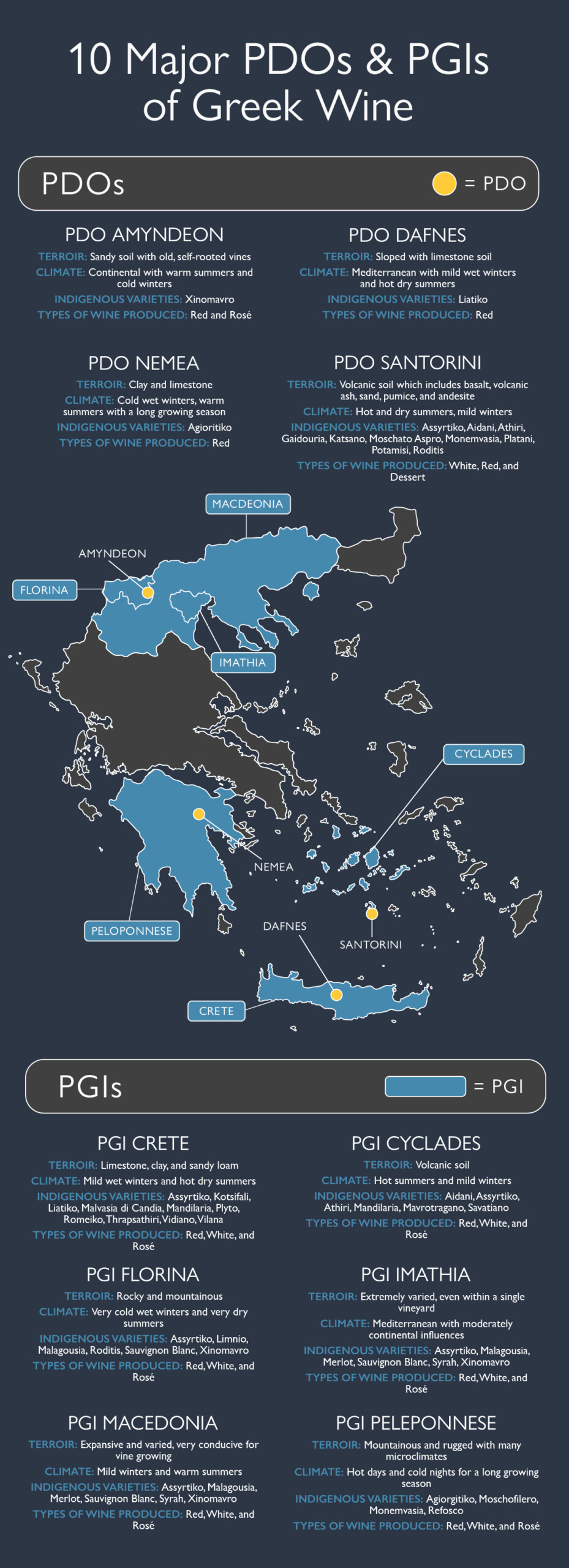![Your Guide to Greek PDOs and PGIs [Infographic]](http://vinepair.com/wp-content/themes/vpcontent/images/blank.gif)
The Greeks’ passion for wine has been a constant for thousands of years. “Evi evan!” was the toast heard at ancient celebrations of Dionysus. Socrates espoused an early version of “drink responsibly” while raising a toast: “Let us be merry but never drunk.” Modern Greeks toast with a hearty and sincere “Yia mas!” which means “to our health!”
Along with the making and enjoyment of wine come rules and regulations. Before forming the European Union (EU), Greek winemaking followed a French model of wine classifications. Greece’s introduction of wine laws in 1971 was an essential step in establishing regulations for the Greek wine industry. The current wine quality indicators in Greece, subject to regulations and guidelines from the Greek Ministry of Rural Development and Food and the European Union, ensure the quality, authenticity, and geographical identity of Greek wines.
The two main Greek wine designations are Protected Designations of Origins (PDO) and Protected Geographical Indicators (PGI). Today, Greece has 33 registered PDOs and 114 PGI appellations for its wines. These indicators ensure the accuracy of the information on labels, the authenticity of the wine’s origin, and the adherence to quality standards.
The PDO and PGI indicators on Greek wines guarantee to the customer of any wine shop anywhere in the world that they will be drinking authentic Greek wine — right down to the vineyard where it was grown by Greece’s proud, passionate, and hard-working farmers and winemakers. The only thing more authentic than the wine in the bottle is the people who make it.
What is the Difference Between Protected Designations of Origins (PDO) and Protected Geographical Indicators (PGI)?
Wines that are classified PDO guarantee that 100 percent of the grapes were grown in the named PDO zone. The wine must also be produced from start to finish within the PDO zone, from growing the grapes to bottling and labeling — when the consumer sees PDO on a bottle of Greek wine, they can be sure they are taking a trip to that specific area of Greece within their glass. The climate, the orientation of the vineyard to the sun and the sea, and the traditional grape varietals in the zone — all are ensured by the letters PDO before the winemaker works their magic.
PDO wines are also required to have additional information on their labels including the aging times in oak barrels or stainless steel tanks, as well as fermentation in bottles before release. There also must be details of the winegrower. PDO wines are easy to spot from a short distance in a wine shop because of the mandatory red band on the bottle’s neck.
PGI Wines
Wines classified with a PGI must be made with at least 80 percent of grapes grown in that area. The law governing the production of the wine is more liberal, stating only one stage must happen within that PGI zone. So, for example, bottling or labeling may happen elsewhere in Greece.
Greece ranks 17th largest among wine-producing countries in the world. In 2021, PDO wines accounted for 9.5 percent of total wine production, while PGI wines accounted for 23.5 percent.
Vine-covered land in Greece is spread among 180,000 growers. When it comes to winemaking, oftentimes a vineyard has been inherited and maintained by a family for generations. Today, there are more than 1,200 wineries in Greece, and the number is steadily rising.
Let’s look at 10 of the major PDOs and PGIs of Greek wine to prepare you for a trip to the often-overlooked hidden gems at your local wine shop’s Greek section.

The wines discussed in this article are available from Diamond Wine Importers.
![The two main Greek wine appellations are Protected Designations of Origins (PDO) and Protected Geographical Indicators (PGI). Your Guide to Greek PDOs and PGIs [Infographic]](https://vinepair.com/wp-content/uploads/2023/05/dwi-infographic-card.jpg)
